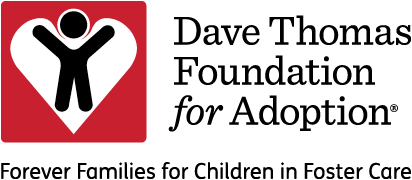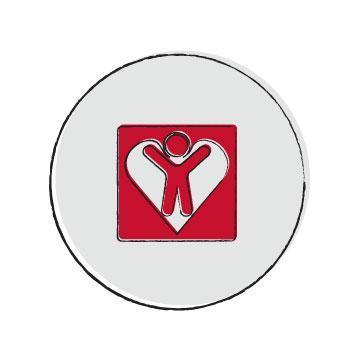FINDING FOREVER FAMILIES: A STEP-BY-STEP GUIDE TO ADOPTION
The Dave Thomas Foundation for Adoption believes that every child deserves a safe, loving and permanent family. Whether you are an adoption professional, a prospective adoptive parent or someone simply interested in learning more about the process, this guide offers valuable information and resources to help you make a difference in the life of a child.
Michael, Roman and Lilliana often lived in separate foster homes as their family of origin struggled with addiction. By the time the siblings were ages 9, 8 and 6, they had spent more than half their lives apart, longing for a permanent place to call home. Thankfully, they were adopted in June by their foster mom, Terri, through the Foundation’s Wendy’s Wonderful Kids program.
Now, Michael, Roman and Lilliana finally have what they always dreamed of: the chance to grow up in a loving family — together. Read their story.
BUILDING YOUR FOREVER FAMILY
Every child has a story to tell, and every adoptive family has its own set of traditions. This makes every adoption unique. But all adoptions share a common process. This guide can help you navigate your adoption journey.
What are the options for adopting a child?
1. Adopting a child from the foster care system
Right now, more than 108,000 children, through no fault of their own, are waiting to be adopted from foster care in the United States. As victims of abuse or neglect, these young people are placed in care because their birth family is unable or unwilling to provide a safe environment for them. The majority are healthy children who simply need and deserve a permanent, loving home.
Unfortunately, the myths, misperceptions and realities surrounding foster care and foster care adoption can give many prospective parents pause. Read 5 common myths.
If you’re interested in foster care adoption, begin by contacting your state’s public agency or another adoption organization, like the Dave Thomas Foundation for Adoption. Through our Wendy’s Wonderful Kids® program, the Foundation supports the hiring of adoption professionals, known as recruiters, who are dedicated to finding forever families for youth in foster care who are most often overlooked.
2. Adopting an infant in the United States
If you would like to adopt a baby, contact your state’s public agency, a licensed private agency or an adoption attorney. A good place to start is to search for “Adoption Organizations” on the Internet. To connect with an adoption attorney, contact your local bar association, the American Academy of Adoption Attorneys or the U.S. Department of Health and Human Services at childwelfare.gov.
3. Adopting a child from another country
Hundreds of thousands of children from around the world who are orphaned need families. Rules governing international adoptions can change quickly and can be complicated. It is important to work with an experienced and ethical agency, group or individual.
If you pursue an international adoption, U.S. Citizenship and Immigration Services requires that you complete a home study. In most cases, the adoption agency or individual you are working with can assist in completing the home study and help you find a child who needs a family.
Learn more
• U.S. Department of State: adoption.state.gov
• National Council for Adoption: adoptioncouncil.org
4. Adopting a stepchild
To learn more about the requirements for stepparent adoption, consult an adoption attorney or contact the court in your state or county that handles adoption. You may also reference the Child Welfare Information Gateway’s stepparent adoption fact sheet.
Which type of adoption best fits with your beliefs and goals as a parent?
Download our adoption guide for reflection questions and resources to inform your decision.
How much will an adoption cost?
The total cost of adoption depends on several factors, such as the type of adoption, the agency through which you adopt, the state in which you live, attorney fees (if applicable) and whether or not travel is required. Foster care adoption typically costs $0 to $5,000 in nominal fees and home studies. International adoption or adoption through a private agency, on the other hand, might cost $30,000 to $60,000 or more. Always request a detailed written explanation of the fees involved before beginning the adoption process.
Financial assistance is available for all types of adoption, including:
- Federal and state subsidies for foster care adoption: These may include monthly cash payments, medical assistance and reimbursements for one-time adoption expenses. For more information about adoption subsidies available in your state, visit Families Rising.
- Loans and grants for individuals.
- Employer benefits: Many organizations offer benefits, such as financial reimbursement, paid leave or other time off, to support employees who adopt. Through our Adoption-Friendly Workplace program, the Dave Thomas Foundation for Adoption provides free resources to educate employers on how to implement adoption benefits.
- Tax credits and exclusions: The federal adoption tax credit is a non-refundable, permanent tax benefit for eligible families who adopt through foster care, internationally and privately. In 2020, the maximum tax credit for qualifying adoption expenses was $14,300 per child. It may be carried forward for five additional years, applying to each year’s liability until the full credit amount is used or time expires. Learn more at irs.gov or speak with your tax advisor.
- Military reimbursements: For active-duty personnel, the military offers up to $2,000 ($5,000 if more than one child is adopted) for qualified adoption expenses per calendar year. For couples who are both in the military, only one member may claim expenses for each adopted child. Visit militaryfamily.org for more information.
To learn more about available support, view the Foundation’s Financial Resources for Adoptive Families page.
Download our adoption guide to learn more and start planning.
How do I find an adoption agency?
Not all adoption agencies are alike, so choose carefully. Some handle the entire adoption process, helping you throughout. Others expect you to take the initiative to learn about procedures and deadlines. Get a sense of how much control you want over the process and then decide on an approach and agency that fits you best.
Find agencies in your area
- Contact your local or state child welfare department for a list of licensed agencies ― both public and private.
- Search online for licensed adoption agencies.
- Connect with adoptive parents or adoptive parent support groups for referrals.
- View a list of Wendy’s Wonderful Kids grantees in your state, if you are interested in foster care adoption.
Learn more about which adoption agency might best align with your beliefs and situation.
What happens after I select an adoption agency?
Once you have selected an agency, it is finally time to begin the formal adoption process. Typically, you will attend an orientation meeting or training session for prospective adoptive parents, where you will:
- Meet social workers and learn about policies and practices.
- Learn about the children who are available for adoption.
- Be asked to examine your feelings about adoption and determine if adoption is the right choice for you.
- Gain insight into the challenges and rewards of adoptive parenting.
- Get application materials.
If possible, attend an orientation session before filling out an application, so you are confident in the agency’s abilities to meet your needs. Application fees are often non-refundable, even if you decide to work through a different agency or change your mind about adopting. Once you have chosen an agency and have completed the application process, ask your social worker how to schedule and prepare for your home study.
Download our guide to learn more about the adoption process.
How do I find a child to adopt?
To begin the search for a child, get in touch with your state agency, your county agency or a private adoption organization in your community.
Several national organizations provide information about waiting children:
- Adopt America Network
- AdoptUSKids, a project of the U.S. Department of Health & Human Services
- Children Awaiting Parents
- Raise the Future
- Northwest Adoption Exchange
The Dave Thomas Foundation for Adoption also offers a comprehensive library of adoption resources.
Get to know your child
When you have found a child and have been identified as their potential family, learn as much as you can about them. Talk to foster parents and social workers.
- How often has the child moved or changed schools while in care?
- Do they still have contact with extended family?
- What are the child’s favorite foods and games?
- What is the best way to comfort the child?
- What is their background?
- What are their birth parents like?
- What are the family’s and child’s medical histories?
These conversations will help you determine whether your family is the right fit for meeting the child’s needs.
If you’re interested in growing your family through adoption, download our guide to get started on your journey.
How do I prepare for an adoption?
It’s time. You know your child, and now they are ready to be placed in your home. What do you need to do to prepare? Here are a few steps to support a smooth transition for both you and the child.
- Contact your insurance company.
- Obtain a copy of your child’s original birth certificate.
- Prepare to get a new Social Security number and birth certificate for your child.
- Organize services for you and your child, such as childcare, school enrollment, and therapy or counseling.
- Make your house child friendly.
- Talk to your other children about what to expect and how they can help welcome their new sibling(s).
Are you ready to explore adoption?
What happens after the child is in my home?
Children who are placed with an adoptive family through a public agency may move in as soon as the parents are approved. This means you have completed all required pre-placement visits and the timing is not disruptive to the child’s schooling or other activities. You assume temporary legal custody of the child once they are placed in your home.
Your adoption agency will monitor the placement while your family adjusts. This monitoring period normally takes about six months but can be as short as a few weeks and as long as a year. A social worker may call or visit to discuss how the placement is working for the child and your family. The next step is for your agency to recommend that the court approve your adoption.
Adoption Petition
With the recommendation of your agency, it’s time to petition to adopt. The petition is the document that makes your adoption legal. On the document, you formally request permission to adopt the child and then file it with the court.
How do I finalize an adoption?
A finalization hearing legally completes the adoption process.* It is when you, the adoptive parent or parents, are given permanent legal custody of the adopted child.
These hearings typically take place within 6-12 months after the child is placed in your home. The court will seek to establish that the child has been placed in a safe, loving family. Be prepared to present all the information included in your adoption petition as well as answer questions, like:
- Why do you want to adopt?
- How will you care for your new child?
- How will your family adjust to the new child?
- Is there anything the court should know before finalizing the adoption?
As soon as the judge signs the adoption order, you gain permanent, legal custody of your child.
*Some states finalize adoptions through paperwork only and there is no hearing.
Are you interested in opening your heart and your home to a child through adoption?
What comes next?
After you’ve finalized your adoption, you’re not all on your own. The Dave Thomas Foundation for Adoption offers a free, step-by-step guide with post-adoption resources. You can also consult your adoption agency or other adoptive parents in your community for recommendations.
For more information, check out these organizations:
Are you ready to get started on your adoption journey?
Download Our Adoption GuidePOST-ADOPTION GUIDE
Even after an adoption is finalized, it is typical for a family to have questions. Strengthen Your Forever Family: A Step-By-Step Guide to Post-Adoption includes helpful resources to support you after the final court hearing.
ADOPTION BENEFITS
The Foundation offers a free toolkit with sample policies to help employers make adoption and foster care supported options for every working parent.



